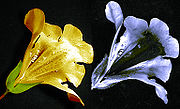
Nectar guide
Encyclopedia

Flower
A flower, sometimes known as a bloom or blossom, is the reproductive structure found in flowering plants . The biological function of a flower is to effect reproduction, usually by providing a mechanism for the union of sperm with eggs...
s, guiding pollinators to their reward
Pollination syndrome
Pollination syndromes are suites of flower traits that have evolved in response to natural selection imposed by different pollen vectors, which can be abiotic or biotic, such as birds, bees, flies, and so forth. These traits include flower shape, size, colour, odour, reward type and amount, nectar...
s. Rewards commonly take the form of nectar
Nectar (plant)
Nectar is a sugar-rich liquid produced by plants. It is produced in glands called nectaries, either within the flowers, in which it attracts pollinating animals, or by extrafloral nectaries, which provide a nutrient source to animal mutualists, which in turn provide anti-herbivore protection...
, pollen
Pollen
Pollen is a fine to coarse powder containing the microgametophytes of seed plants, which produce the male gametes . Pollen grains have a hard coat that protects the sperm cells during the process of their movement from the stamens to the pistil of flowering plants or from the male cone to the...
, or both, but various plants produce oil, resins, scents, or waxes. Such patterns also are known as "pollen guides" and "honey guides", though some authorities argue for the abandonment of such terms in favour of floral guides (see for example Dinkel & Lunau).
These patterns are sometimes visible to humans; for instance, the Dalmatian toadflax
Linaria
Linaria is a genus of about 100 species of herbaceous annuals and perennials that was traditionally placed in the figwort family Scrophulariaceae. Due to new genetic research, it has now been placed in the vastly expanded family Plantaginaceae...
(Linaria genistifolia) has yellow flowers with orange nectar guides. However, in some plants, such as sunflower
Sunflower
Sunflower is an annual plant native to the Americas. It possesses a large inflorescence . The sunflower got its name from its huge, fiery blooms, whose shape and image is often used to depict the sun. The sunflower has a rough, hairy stem, broad, coarsely toothed, rough leaves and circular heads...
s, they are visible only under ultraviolet
Ultraviolet
Ultraviolet light is electromagnetic radiation with a wavelength shorter than that of visible light, but longer than X-rays, in the range 10 nm to 400 nm, and energies from 3 eV to 124 eV...
light
Light
Light or visible light is electromagnetic radiation that is visible to the human eye, and is responsible for the sense of sight. Visible light has wavelength in a range from about 380 nanometres to about 740 nm, with a frequency range of about 405 THz to 790 THz...
. Under ultraviolet, the flowers have a darker center, where the nectaries are located, and often specific patterns upon the petals as well. This is believed to make the flowers more attractive to pollinator
Pollinator
A pollinator is the biotic agent that moves pollen from the male anthers of a flower to the female stigma of a flower to accomplish fertilization or syngamy of the female gamete in the ovule of the flower by the male gamete from the pollen grain...
s such as honey bee
Honey bee
Honey bees are a subset of bees in the genus Apis, primarily distinguished by the production and storage of honey and the construction of perennial, colonial nests out of wax. Honey bees are the only extant members of the tribe Apini, all in the genus Apis...
s and other insect
Insect
Insects are a class of living creatures within the arthropods that have a chitinous exoskeleton, a three-part body , three pairs of jointed legs, compound eyes, and two antennae...
s that can see ultraviolet. This page on butterflies shows an animated comparison of black-eyed Susan
Rudbeckia hirta
Rudbeckia hirta, the Black-eyed Susan, with the other common names of: Brown-eyed Susan, Brown Betty, Brown Daisy , Gloriosa Daisy, Golden Jerusalem, Poorland Daisy, Yellow Daisy, and Yellow Ox-eye Daisy. It is a flowering plant in the family Asteraceae...
(Rudbeckia hirta) flowers in visible and UV light.
The ultraviolet color, invisible to humans, has been referred to as bee violet, and mixtures of greenish (yellow
Yellow
Yellow is the color evoked by light that stimulates both the L and M cone cells of the retina about equally, with no significant stimulation of the S cone cells. Light with a wavelength of 570–590 nm is yellow, as is light with a suitable mixture of red and green...
) wavelengths (roughly 540 nm) with ultraviolet are called bee purple by analogy with purple
Purple
Purple is a range of hues of color occurring between red and blue, and is classified as a secondary color as the colors are required to create the shade....
in human vision.
External links
- Dalmatian Toadflax from the Southwest Exotic Plant Information Clearinghouse.
(See archived version on the Internet Archive -- accessed on 2009-03-17).

